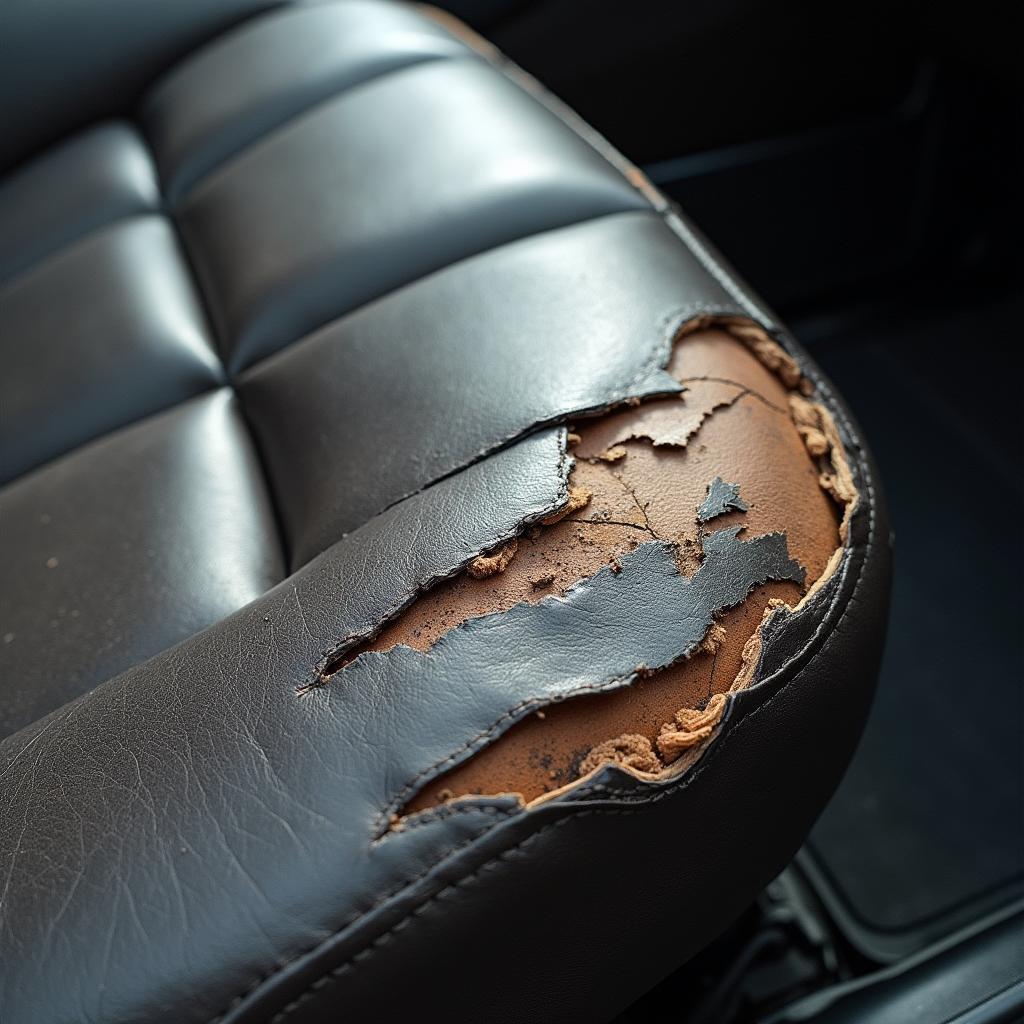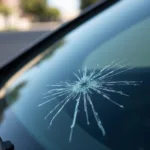A ripped leather car seat can be a real eyesore, detracting from the overall aesthetic of your vehicle’s interior. While it might seem like a daunting task, repairing a ripped leather car seat is often achievable with the right tools, materials, and a little bit of patience. Whether you’re dealing with a minor scratch, a small tear, or a larger rip, this comprehensive guide will provide you with expert advice and step-by-step instructions to help you restore your leather car seats to their former glory.
Understanding the Different Types of Leather Car Seat Damage
Before diving into the repair process, it’s crucial to identify the type of damage your leather car seats have sustained.
- Scratches: These are superficial marks on the leather’s surface, often caused by sharp objects or friction.
- Tears: These are deeper cuts or splits in the leather, exposing the underlying material.
- Burns: These are caused by heat sources like cigarettes or hot liquids, leaving behind discolored or charred areas.
- Cracks: These are often a result of age, wear, and exposure to extreme temperatures, leading to dryness and eventual cracking of the leather.
Each type of damage requires a slightly different approach to repair, so accurate identification is key to achieving the best results.
Essential Tools and Materials for Leather Car Seat Repair
Having the right tools and materials on hand will make the repair process smoother and more effective. Here’s a list of what you’ll need:
- Leather cleaner and conditioner: To prep the area and restore the leather’s suppleness.
- Leather repair kit: These typically include a color-matched filler compound, adhesive, backing fabric, a spatula, and a grain paper.
- Scissors: For cutting the backing fabric and grain paper to size.
- Heat gun or hairdryer: To accelerate the drying process of the filler compound.
- Rubbing alcohol: For cleaning the damaged area and ensuring proper adhesion.
- Soft cloths: For applying various products and buffing the repaired area.
Step-by-Step Guide to Repairing a Ripped Leather Car Seat
Follow these steps to effectively repair a ripped leather car seat:
- Clean the Area: Start by thoroughly cleaning the damaged area and its surroundings with a suitable leather cleaner. Use a soft cloth and gentle circular motions to remove dirt, grime, and any residues that might hinder adhesion.
- Trim Loose Edges: If there are any loose or frayed edges around the rip, carefully trim them with a pair of sharp scissors. This will create a cleaner surface for the repair compound to adhere to.
- Apply the Backing Fabric (If Necessary): For larger tears or holes, it’s essential to provide support behind the rip. Cut a piece of backing fabric slightly larger than the damaged area and use the adhesive from the leather repair kit to secure it behind the tear.
- Fill the Rip: Apply the leather filler compound to the ripped area using the spatula. Ensure the filler compound completely fills the gap and slightly overlaps the surrounding leather.
- Create the Leather Grain: While the filler compound is still wet, place a piece of grain paper over the repaired area. The grain paper will imprint a texture on the filler compound, mimicking the look and feel of natural leather.
- Heat and Dry: Use a heat gun or hairdryer to carefully heat the grain paper, allowing the filler compound to dry and cure faster. Be sure to keep the heat source moving to avoid overheating and damaging the leather.
- Sand and Blend: Once the filler compound is completely dry, gently sand the repaired area with fine-grit sandpaper to create a smooth and seamless transition between the repaired section and the original leather.
- Apply Leather Dye (If Needed): If the color of the repaired area doesn’t perfectly match the surrounding leather, you can use a leather dye to achieve a seamless blend. Apply the dye according to the manufacturer’s instructions, using a soft cloth or sponge applicator.
- Condition the Leather: To complete the repair process and restore the leather’s suppleness, apply a high-quality leather conditioner to the entire seat. This will help keep the leather moisturized, prevent future cracking, and maintain its newly restored look.
Tips for Achieving Professional-Looking Results
- Choose the Right Repair Kit: Opt for a leather repair kit that specifically matches the color and grain of your car’s leather upholstery.
- Work in a Well-Ventilated Area: Many leather repair products emit fumes, so it’s essential to work in a well-ventilated area or outdoors to avoid inhaling harmful vapors.
- Be Patient and Take Your Time: Rushing the repair process can lead to subpar results. Allow ample drying time for the filler compound and apply thin, even coats of dye if needed.
- Consider Professional Repair for Extensive Damage: For significant damage, such as large tears, burns, or extensive cracking, seeking professional leather repair services might be the best course of action.
Can You Repair Ripped Leather Car Seats Yourself?
Yes, repairing minor to moderate damage on leather car seats is often achievable with a DIY approach. However, for more extensive damage or if you’re unsure about your skills, consulting a professional leather repair specialist is recommended. They have the expertise and specialized tools to handle complex repairs and can ensure a flawless finish.
How Much Does It Cost to Repair Ripped Leather Car Seats?
The cost of repairing ripped leather car seats can vary depending on factors like the extent of the damage, the type of leather, and labor costs in your area. DIY repairs using a leather repair kit can range from $20 to $50, while professional repairs can cost anywhere from $100 to $500 or more for extensive damage.
how to repair ripped leather seats in car
Audi A5 Leather Car Seat Seam Repair: A Specific Example
While the general principles of leather car seat repair apply to most vehicles, certain models might have unique considerations. For instance, Audi A5 models are known for their high-quality leather upholstery, which might require specialized repair techniques or products.
If you’re dealing with a ripped leather car seat seam on your Audi A5, it’s crucial to use a repair kit and techniques that are compatible with the specific type of leather used in your vehicle. Consulting an Audi dealership or a professional leather repair specialist experienced with Audi vehicles can provide valuable insights and ensure a successful repair.
audi a5 leather car seat seam repair
Car Leather Seat Repair Dye: Choosing the Right One
Selecting the right car leather seat repair dye is crucial for achieving a seamless and invisible repair. When choosing a dye, consider the following:
- Color Matching: Ensure the dye color perfectly matches the existing leather color. It’s helpful to test the dye on a hidden area of the seat first to guarantee a perfect match.
- Leather Compatibility: Choose a dye specifically designed for use on automotive leather. Different types of leather might require different dye formulations.
- Durability and Fade Resistance: Opt for a dye that offers excellent durability and resistance to fading, cracking, and peeling.
Conclusion
Repairing ripped leather car seats is a manageable task that can significantly enhance the overall appearance and value of your vehicle’s interior. By following the steps outlined in this guide and arming yourself with the right tools and materials, you can confidently tackle minor to moderate leather repairs and restore your car seats to their former glory. However, remember that professional repair is always an option for extensive damage or if you prefer to leave it to the experts.
can you repair ripped leather car seats
FAQ
1. Can I use super glue to repair a ripped leather car seat?
While super glue might seem like a quick fix, it’s not recommended for repairing leather car seats. Super glue can create a stiff and inflexible bond that can crack or break over time. Additionally, it doesn’t provide a seamless or professional-looking finish.
2. How long does it take for leather filler compound to dry?
The drying time for leather filler compound varies depending on the product and environmental conditions. Generally, it can take anywhere from a few hours to overnight for the compound to fully cure.
3. Can I prevent future rips and tears in my leather car seats?
Regularly cleaning and conditioning your leather car seats can help keep the leather supple and prevent drying, cracking, and tearing. Additionally, using seat covers can provide an extra layer of protection against wear and tear.
4. What should I do if the repaired area feels stiff or rough after drying?
If the repaired area feels stiff or rough, you can gently sand it with fine-grit sandpaper to smooth out any imperfections. Afterward, apply a leather conditioner to restore its softness and flexibility.
5. Can I repair burns or heat marks on my leather car seats?
Repairing burns or heat marks on leather car seats can be challenging and often requires professional expertise. In some cases, sanding and dyeing might help minimize the appearance of minor heat damage, but deeper burns might require patching or replacement of the affected panel.
6. Where can I find professional leather car seat repair services near me?
You can search online directories, automotive forums, or ask for recommendations from friends, family, or your local auto repair shops to find reputable leather car seat repair services in your area.
7. How much does it cost to reupholster car seats with leather?
Reupholstering car seats with leather can be a more expensive option than repairing minor damage, but it can be a worthwhile investment if your car seats are severely damaged or you want to upgrade to a different leather type or color. The cost of leather car seat upholstery can range from several hundred to several thousand dollars, depending on factors like the vehicle model, leather type, and labor costs.
Still have questions or need assistance with your ripped leather car seats? Feel free to reach out to our team of experts. We’re available 24/7 to answer your questions and provide guidance. Contact us via WhatsApp: +1(641)206-8880, or Email: [email protected].


